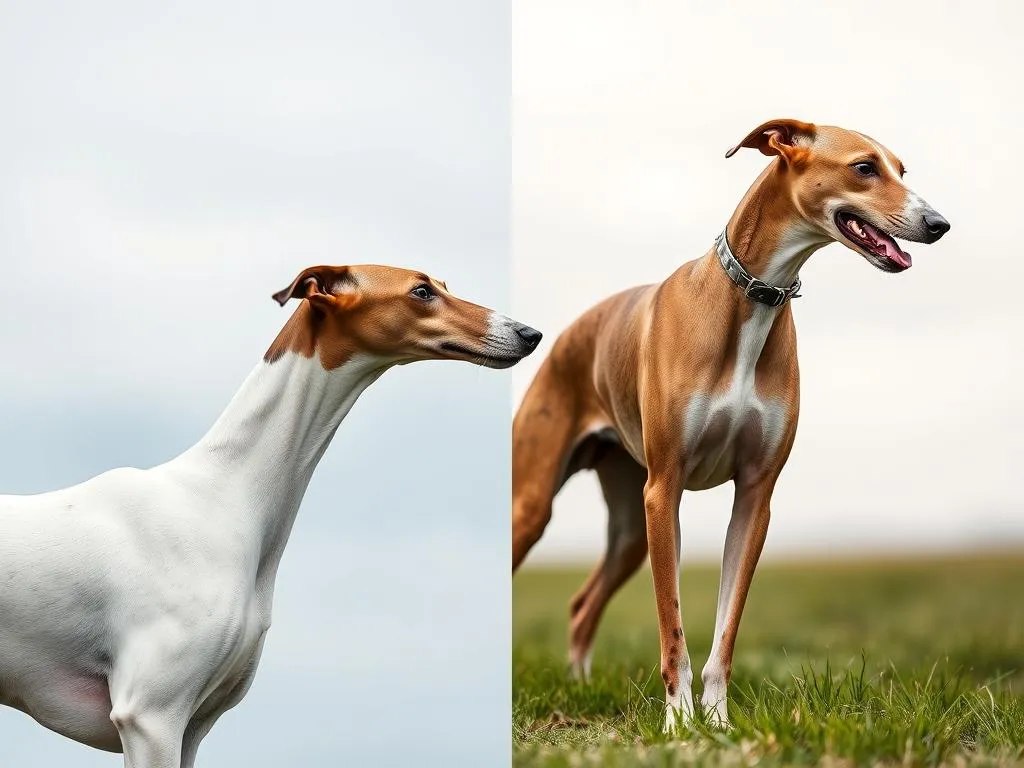
Dog breeds play a significant role in our lives, providing companionship, love, and joy. For potential dog owners, understanding different breeds is crucial to making an informed choice. In this article, we will delve into an in-depth comparison of Whippets and Greyhounds. By the end, you’ll have a clearer understanding of which breed might be the best fit for you.
Overview of Whippets and Greyhounds
Whippets
Whippets originated in England in the 19th century, bred primarily for hunting small game and racing. These elegant dogs are often described as “miniature Greyhounds” due to their similar appearance but smaller stature.
Physical Characteristics:
Whippets typically weigh between 25 to 40 pounds and stand about 18 to 22 inches tall at the shoulder. Their coats are short and sleek, coming in various colors and patterns, including fawn, brindle, and white.
Temperament and Personality Traits:
Whippets are known for their gentle and affectionate nature. They are friendly, social dogs that typically get along well with children and other pets. Their playful demeanor makes them great companions, although they can also be quite laid-back.
Common Health Issues:
While generally healthy, Whippets can be predisposed to certain health issues, including hip dysplasia and heart problems. Regular check-ups with a veterinarian can help monitor their health.
Greyhounds
Greyhounds have a long and storied history as one of the oldest dog breeds, dating back over 4,000 years. Originally bred for hunting and racing, they are now primarily kept as family pets.
Physical Characteristics:
Greyhounds are larger and more robust than Whippets, weighing between 60 to 70 pounds and measuring 24 to 30 inches tall. Their coats are also short and smooth, coming in a variety of colors such as black, fawn, and blue.
Temperament and Personality Traits:
Known for their calm and friendly disposition, Greyhounds are surprisingly low-energy dogs despite their racing background. They are gentle and affectionate, making them excellent companions for families and singles alike.
Common Health Issues:
Greyhounds are generally healthy dogs, but they can be susceptible to bloat, hip dysplasia, and certain cancers. Regular veterinary care is essential to ensure their well-being.
Key Differences Between Whippets and Greyhounds
Physical Differences
Size Comparison:
The most apparent difference between Whippets and Greyhounds is their size. Whippets are considerably smaller, making them suitable for apartment living, while Greyhounds require more space due to their larger size.
Build and Structure:
Whippets have a more delicate build compared to the muscular Greyhound. This difference in structure contributes to their unique running styles; Whippets are agile and quick, while Greyhounds are built for speed.
Coat and Color Variations:
Both breeds have short coats, but Greyhounds can have a wider range of colors. Whippets often have more intricate patterns, including spots and brindle markings.
Temperament and Behavior
Energy Levels and Activity Requirements:
While both breeds enjoy running, their energy levels differ. Whippets require regular exercise but are content with a good sprint and then relaxing. In contrast, Greyhounds tend to have bursts of energy but are very comfortable lounging around for most of the day.
Socialization with Other Pets and People:
Both breeds are generally friendly, but Whippets may have a higher prey drive due to their history as hunters. This can sometimes affect their interactions with smaller animals. Greyhounds, on the other hand, typically have a more laid-back approach to socialization.
Trainability and Intelligence:
Both breeds are intelligent, but training methods may vary. Whippets can be somewhat stubborn, requiring patience and consistency. Greyhounds are generally more eager to please, making them easier to train.
Health Considerations
Lifespan Comparison:
Whippets typically live longer than Greyhounds, with a lifespan of around 12 to 15 years, while Greyhounds average about 10 to 14 years.
Common Breed-Specific Health Concerns:
Both breeds have specific health issues, with Whippets facing heart problems and hip dysplasia, while Greyhounds are more prone to bloat and certain types of cancer.
Recommended Health Screenings and Preventative Care:
Routine vet visits are essential for both breeds. Preventative care should include screenings for heart issues in Whippets and bloat in Greyhounds.
Lifestyle Compatibility
Ideal Living Conditions
Space Requirements:
Whippets are more adaptable to apartment living due to their smaller size and lower exercise needs. Greyhounds, while also adaptable, may benefit from a home with a yard to stretch their legs.
Exercise Needs and Daily Routines:
Whippets need daily exercise, including walks and playtime, while Greyhounds require less frequent but more intense bursts of activity. Both breeds enjoy running, but Whippets are more playful and active throughout the day.
Climate Adaptability:
Both breeds are sensitive to extreme temperatures. Whippets tend to be more susceptible to the cold due to their thin coats, while Greyhounds can struggle in very hot weather. Both breeds should be monitored for temperature-related issues.
Family Compatibility
Suitability for Families with Children:
Both breeds are generally good with children, but Whippets may be better suited for families with active kids due to their playful nature. Greyhounds are calm and gentle, making them excellent companions for quieter households.
Interaction with Other Pets:
Whippets may have a higher prey drive, which could lead to challenges when living with smaller animals. Greyhounds are usually more accepting of other pets, but early socialization is essential.
Age Considerations for Potential Owners:
Both breeds can fit well into various lifestyles, but Whippets may be better suited for younger, active families, while Greyhounds might appeal to older adults or those looking for a calmer companion.
Training and Care
Training Techniques
Basic Training Tips for Whippets:
– Use positive reinforcement techniques, such as treats and praise.
– Start training early to establish good habits.
– Keep training sessions short and engaging to hold their attention.
Basic Training Tips for Greyhounds:
– Consistency is key; establish a routine for training.
– Utilize their eagerness to please by rewarding good behavior.
– Socialization is crucial; expose them to various environments and people.
Differences in Training Challenges and Rewards:
Whippets may require more patience due to their independent nature, while Greyhounds are typically easier to train. However, both breeds can be rewarding companions when properly trained.
Grooming and Maintenance
Grooming Needs for Whippets:
Whippets have relatively low grooming needs. Their short coats require occasional brushing to remove loose hair, and they should be bathed as needed.
Grooming Needs for Greyhounds:
Like Whippets, Greyhounds have low grooming requirements. Regular brushing helps keep their coat healthy, and they should also be bathed periodically.
Seasonal Care Considerations:
Both breeds can benefit from seasonal care, such as providing warmth in colder months and ensuring hydration during hot weather.
Nutrition and Diet
Recommended Diets for Each Breed:
Both Whippets and Greyhounds require a high-quality diet to support their energy levels. Look for dog food that includes protein as the primary ingredient and avoid fillers.
Common Dietary Issues and How to Address Them:
Watch for food sensitivities, especially in Whippets, which may lead to digestive issues. Consult your veterinarian for dietary recommendations tailored to your dog’s specific needs.
Cost of Ownership
Initial Purchase Price
Average Price Range for Adopting or Purchasing Each Breed:
The cost of a Whippet can range from $1,000 to $2,500, while Greyhounds can often be adopted for $200 to $500 from rescue organizations. Factors influencing cost include breeder reputation and lineage.
Ongoing Expenses
Food, Grooming, and Healthcare Costs:
Ongoing expenses for both breeds include quality dog food, routine veterinary care, and occasional grooming services. Expect to spend around $50 to $100 monthly on food alone, depending on the dog’s size and dietary needs.
Potential Training and Boarding Expenses:
Training classes can range from $100 to $300, depending on the type and duration of the course. If you travel, consider the cost of boarding or pet-sitting services.
Insurance Considerations
Average Cost of Pet Insurance for Whippets vs. Greyhounds:
Pet insurance typically ranges from $30 to $60 per month for both breeds. However, the specific costs may vary based on the provider and coverage options.
Coverage Differences and Recommendations:
Look for insurance plans that cover breed-specific issues and provide wellness benefits for routine care.
Conclusion
In summary, both Whippets and Greyhounds offer unique traits and characteristics that cater to different lifestyles and preferences. Whippets tend to be more energetic and playful, making them ideal for active families, while Greyhounds are calm and gentle, appealing to those seeking a relaxed companion.
When choosing between these two breeds, consider your living situation, family dynamics, and personal preferences. Each dog has its charm, so take the time to meet them and understand how they fit into your life.









